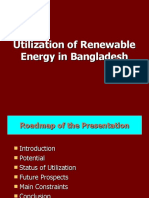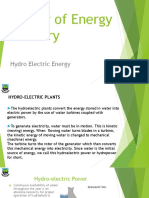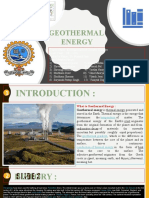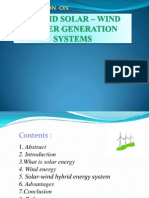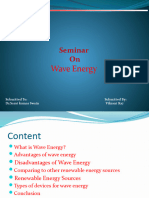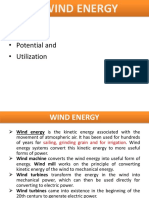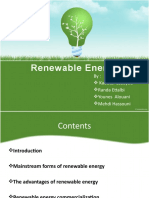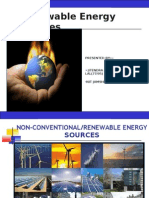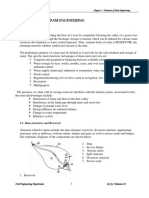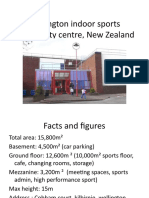0 ratings0% found this document useful (0 votes)
115 viewsLesson 14
Wave energy devices capture energy from ocean waves in various ways. There are five main types of technologies: absorbers, attenuators, oscillating water columns, overtopping devices, and inverted pendulum devices. Absorbers extract energy from wave rise and fall using a buoy connected to a generator. Attenuators flex with waves to drive hydraulic pumps. Oscillating water columns use air pressure changes from wave water level changes to power turbines. Overtopping fills reservoirs to drain through turbines. Inverted pendulums use wave motion to drive pumps and generators.
Uploaded by
die hard gamerCopyright
© © All Rights Reserved
Available Formats
Download as PPTX, PDF, TXT or read online on Scribd
0 ratings0% found this document useful (0 votes)
115 viewsLesson 14
Wave energy devices capture energy from ocean waves in various ways. There are five main types of technologies: absorbers, attenuators, oscillating water columns, overtopping devices, and inverted pendulum devices. Absorbers extract energy from wave rise and fall using a buoy connected to a generator. Attenuators flex with waves to drive hydraulic pumps. Oscillating water columns use air pressure changes from wave water level changes to power turbines. Overtopping fills reservoirs to drain through turbines. Inverted pendulums use wave motion to drive pumps and generators.
Uploaded by
die hard gamerCopyright
© © All Rights Reserved
Available Formats
Download as PPTX, PDF, TXT or read online on Scribd
You are on page 1/ 23
Wave energy devices
Wave energy (or wave power) is the capture of
energy by ocean surface waves used for all
different kinds of useful work, including
electricity generation, water desalination, and
pumping of water.
There are multiple different technologies used
for Wave energy. There are five main types of
technology used including; Absorbers,
Attenuators, Oscillation water columns,
overtopping and Inverted- Pendulum device.
Absorbers extract energy from the rise and fall
of the waves with a buoy. Once the energy is
extracted it is then converted to electrical energy
with a linear or rotary generator.
Attenuators capture energy by being placed
perpendicular to the length of the wave, which
causes the attenuator to contentiously flex where
segments are connected. This connection is then
connected to hydraulic pumps which convert the
energy.
Oscillation Water Columns (OWC) is a
partially submerged enclosed structure. The upper
part of the structure, above the water, is filled
with air and incoming waves are funneled into the
bottom part of the structure.
When these waves come through the structure it
causes the water column to rise and fall with the
wave which causes the air in the top structure to
pressurize and depressurize.
This in turn pushes and pulls air through a
connected air turbine at the top of the structure,
converting the energy.
Overtopping has a wave lift over a barrier which
fills a reservoir with the water and is then drained
through a hydro turbine. This technology is very
similar to a conventional hydropower dam.
Inverted-Pendulum device uses the motion of
waves to move a hinged paddle back and forth. The
motion of the paddle drives hydraulic pumps which
drives electrical generators.
Further there are three fundamental but very
different wave energy devices used in converting
wave power into electric power, and these are:
1.Wave Profile Devices these are wave energy
devices which turn the oscillating height of the
ocean’s surface into mechanical energy.
2. Oscillating Water Columns these are wave
energy devices which convert the energy of the
waves into air pressure.
3.Wave Capture Devices these are wave energy
devices which convert the energy of the waves into
potential energy.
Wave Profile Devices
Wave profile devices are a class of wave energy
device which floats on or near to the sea surface
and moves in response to the shape of the incident
wave or, for submersible devices, it moves up and
down under the influence of the variations in
underwater pressure as a wave moves by.
Most types of wave profile devices float on the
surface absorbing the wave energy in all directions
by following the movements of waves at or near
the sea surface, just like a float.
If the physical size of the wave profile device is
very small compared to the periodic length of the
wave, this type of wave energy device is called a
“point absorber”.
If the size of the device is larger or longer than
the typical periodic wavelength, it is called a
“linear absorber”
The waves energy is absorbed using vertical
motion (heave), horizontal motion in the direction
of wave travel (surge), angular motion about a
central axis parallel to the wave crests (pitch) or
angular motion about a vertical axis (yaw) or a
combination of all four with the energy being
generated by reacting these different movements
against some kind of fixed resistance called
a reaction point.
Working
•The pitching and heaving of the waves causes a
relative motion between an absorber and reaction
point. The left hand wave energy device above
uses a heavy ballast plate suspended below the
floating buoy.
•As the buoy bobs up-and-down in the waves, a
oscillatory mutual force reaction is generated
between the freely moving absorber and the heavy
plate causing a hydraulic pump in between to
rotate a generator producing electricity.
•The third device is an example of a linear absorber
(wave attenuator) which floats on the surface of the
water. It to is tethered to the ocean floor so that it
can swing perpendicularly towards the incoming
waves. As the waves pass along the length of this
snake like wave energy device, they cause the long
cylindrical body to sag downwards into the troughs
of the waves and arch upwards when the waves
crest is passing.
The Pelamis Wave Energy Converter
The Pelamis Wave Energy Converter is a technology that
used the motion of ocean surface waves to create electricity.
It is a semi-submerged machine, articulated structure
composed of cylindrical sections linked by hinged joints.
The machine responds to the curvature of the waves rather
than the wave height.
As waves can only reach a certain curvature before naturally
breaking, this limits the range of motion through which the
machine must move but maintains large motion at the joints
in small waves.
One advantage of the Pelamis design is that several offshore
devices can be connected and linked together to the shoreline
through a single submersible underwater cable.
Operation:
The Pelamis machine is an offshore wave energy converter,
operating in water depths greater than 50m.
The machine consists of a series of semi-submerged cylindrical
sections linked by hinged joints.
As waves pass along the length of the machine, the sections
move relative to one another.
The wave-induced motion of the sections is resisted
by hydraulic cylinders which pump high pressure oil
through hydraulic motors via smoothing hydraulic accumulators.
The hydraulic motors drive electrical generators to produce
electricity.
Electricity from all the joints is fed down a single umbilical
cable to a junction on the sea bed.
Several devices can be connected and linked to shore through a
single seabed cable
Oscillating Water Column
The Oscillating Water Column, (OWC) is a
popular shoreline wave energy device normally
positioned onto or near to rocks or cliffs which are
next to a deep sea bottom.
They consist of a partly submerged hollow
chamber fixed directly at the shoreline which
converts wave energy into air pressure.
The structure used to capture the waves energy
could be a natural cave with a blow hole or a man
made chamber or duct with a wind turbine
generator located at the top well above the water’s
surface.
Either way, the structure is built perpendicular to
the waves with part of the ocean surface trapped
inside the chamber which itself is open to the sea
below the water line.
The advantage of this shoreline scheme is that
the main moving part, the turbine can be easily
removed for repair or maintenance because it is on
land.
The disadvantage though is that, as with the
previous wave energy devices, the oscillating
wave columns output is dependent on the level of
wave energy, which varies day by day according to
the season.
Working:
As the incident waves outside enter and exit the
chamber, changes in wave movement on the
opening cause the water level within the enclosure
to oscillate up and down acting like a giant piston
on the air above the surface of the water, pushing it
back and forth.
This air is compressed and decompressed by this
movement every cycle. The air is channeled
through a wind turbine generator to produce
electricity.
The Wells turbine has the remarkable property of rotating in
the same direction regardless of the direction of air flow in the
column.
The kinetic energy is extracted from the reversing air flow
by the Wells turbine and is used to drive an electrical induction
generator.
The speed of the air flow through the wells turbine can be
enhanced by making the cross-sectional area of the wave
turbines duct much less than that of the sea column.
The air inside the chamber is constantly
reversing direction with every up-and-down
movement of the sea water producing a sucking
and blowing effect through the turbine.
If a conventional turbine was used to drive the
attached generator, this too would be constantly
changing direction in unison with the air flow.
To overcome this problem the type of wind
turbine used in oscillating water column schemes
is called a Wells Turbine.
Wave Capture Device
• A Wave Capture Device also known as a Overtopping Wave
Power Device, is a shoreline to near shore wave energy
device that captures the movements of the tides and waves
and converts it into potential energy.
• Wave energy is converted into potential energy by lifting the
water up onto a higher level.
• The overtopping wave energy converter works in much the
same way as an impoundment type hydroelectric dam works.
• Sea water is captured and impounded at a height above sea
level creating a low head situation which is then drained out
through a reaction turbine.
Working:
The basic water impoundment structure can be either
fixed or a floating structure tethered to the sea bed.
The wave overtopping device uses a ramp design on the
device to elevate part of the incoming waves above their
natural height.
As the waves hit the structure they flow up a ramp and
over the top into a raised water impoundment reservoir on
the device in order to fill it.
Once captured, the potential energy of the trapped water
in the reservoir is extracted using gravity as the water
returns to the sea via a low-head turbine generator located
at the bottom of the wave capture device.
You might also like
- Lecture - 1 Components of Sewage Collection System100% (1)Lecture - 1 Components of Sewage Collection System19 pages
- Makerere University: College of Engineering Design, Art and TechnologyNo ratings yetMakerere University: College of Engineering Design, Art and Technology18 pages
- The Prospect of Wind Energy Generation and Storage System in The PhilippinesNo ratings yetThe Prospect of Wind Energy Generation and Storage System in The Philippines18 pages
- Energy Conservation and Environmental ProtectionNo ratings yetEnergy Conservation and Environmental Protection22 pages
- Tribhuwan University Institute of Engineering Pashchimanchal CampusNo ratings yetTribhuwan University Institute of Engineering Pashchimanchal Campus38 pages
- University of Nigeria, Nsukka: Faculty of Engineering Department of Mechanical EngineeringNo ratings yetUniversity of Nigeria, Nsukka: Faculty of Engineering Department of Mechanical Engineering14 pages
- Hybrid Solar - Wind Power Generation SystemsNo ratings yetHybrid Solar - Wind Power Generation Systems14 pages
- Lecture 5 - Marine and Wind Energy Conversion SystemNo ratings yetLecture 5 - Marine and Wind Energy Conversion System147 pages
- Tidal Energy: Student Name: Akhil Alle Student Number: W19049340 Module Code: Kd7068No ratings yetTidal Energy: Student Name: Akhil Alle Student Number: W19049340 Module Code: Kd706818 pages
- Hydraulic Turbines: Device For Exchange of Energy Between A Fluid Medium and A Mechanical System100% (1)Hydraulic Turbines: Device For Exchange of Energy Between A Fluid Medium and A Mechanical System35 pages
- Solutions Manual for Advanced Energy Systems Second Edition Nikolai V. Khartchenko - The latest ebook edition with all chapters is now available100% (3)Solutions Manual for Advanced Energy Systems Second Edition Nikolai V. Khartchenko - The latest ebook edition with all chapters is now available73 pages
- 18CHO101T: Sustainable Energy EngineeringNo ratings yet18CHO101T: Sustainable Energy Engineering62 pages
- U.S. Renewable Energy Factsheet CSS03-12 E2018No ratings yetU.S. Renewable Energy Factsheet CSS03-12 E20182 pages
- Geothermal Energy: PPT Made By:-Aryan Kumar SinghNo ratings yetGeothermal Energy: PPT Made By:-Aryan Kumar Singh16 pages
- EGN 4333 - Lecture LO1 Various Energy Sources - (Reduced Version WT Animation)No ratings yetEGN 4333 - Lecture LO1 Various Energy Sources - (Reduced Version WT Animation)52 pages
- How Do Wind Turbines Generate Electricity?No ratings yetHow Do Wind Turbines Generate Electricity?2 pages
- Mekelle University Ethiopian Institute of Technology-Mekelle Electrical and Computer Engineering DepartmentNo ratings yetMekelle University Ethiopian Institute of Technology-Mekelle Electrical and Computer Engineering Department2 pages
- Wind Turbine Generators For Wind Power PlantsNo ratings yetWind Turbine Generators For Wind Power Plants43 pages
- Renewable Energy: By: Kaoutar Esbayou Randa Ettalbi Younes Alouani Mehdi HassouniNo ratings yetRenewable Energy: By: Kaoutar Esbayou Randa Ettalbi Younes Alouani Mehdi Hassouni12 pages
- Geothermal Power Plant (Case Problem) : Answers: (A) 267.4°F, (B) 29.7Mbtu/H, (C) 187,120 LBM/H, (D) 10.8 PercentNo ratings yetGeothermal Power Plant (Case Problem) : Answers: (A) 267.4°F, (B) 29.7Mbtu/H, (C) 187,120 LBM/H, (D) 10.8 Percent1 page
- A Case Study for a Single-Phase Inverter Photovoltaic System of a Three-Bedroom Apartment Located in Alexandria, Egypt: building industry, #0From EverandA Case Study for a Single-Phase Inverter Photovoltaic System of a Three-Bedroom Apartment Located in Alexandria, Egypt: building industry, #0No ratings yet
- Renewable Energy Tariffs and Incentives in Indonesia: Review and RecommendationsFrom EverandRenewable Energy Tariffs and Incentives in Indonesia: Review and RecommendationsNo ratings yet
- Wave Energy Devices: Devices That Harness The Energy of The WavesNo ratings yetWave Energy Devices: Devices That Harness The Energy of The Waves5 pages
- Instant Ebooks Textbook (Ebook PDF) Living in The Environment 20th Edition Download All Chapters100% (6)Instant Ebooks Textbook (Ebook PDF) Living in The Environment 20th Edition Download All Chapters49 pages
- Targets/Planned Outputs Actual Accomplishment Percentage MOVNo ratings yetTargets/Planned Outputs Actual Accomplishment Percentage MOV4 pages
- Sanitation Options in Rural and Urban Areas Best PNo ratings yetSanitation Options in Rural and Urban Areas Best P6 pages
- 8th April 2022 NITTTR - ECBC & State PoliciesNo ratings yet8th April 2022 NITTTR - ECBC & State Policies117 pages
- Lecture On Biodiversity: Introduction To Environmental Science100% (1)Lecture On Biodiversity: Introduction To Environmental Science70 pages
- Practicum Video Lesson 2 Ss Micro-TeachingNo ratings yetPracticum Video Lesson 2 Ss Micro-Teaching4 pages
- Design of Sewerage System (A3 Size Print)No ratings yetDesign of Sewerage System (A3 Size Print)2 pages
- Introduction Company Involved Objective of Bertam MelakaNo ratings yetIntroduction Company Involved Objective of Bertam Melaka4 pages
- Wellington Indoor Sports Community Centre, New ZealandNo ratings yetWellington Indoor Sports Community Centre, New Zealand27 pages
- Indian Standard: Glossary of Terms Relating To River Valley ProjectsNo ratings yetIndian Standard: Glossary of Terms Relating To River Valley Projects16 pages
- LearnEnglish Listening A2 Facts and FiguresNo ratings yetLearnEnglish Listening A2 Facts and Figures4 pages
- E10380v50EA0P0101PUBLIC10SEAR1Total PDFNo ratings yetE10380v50EA0P0101PUBLIC10SEAR1Total PDF389 pages
- Mumbai Rains - Why The City Is Most Vulnerable To Urban Flooding - Gitanjali ChandrasekharanNo ratings yetMumbai Rains - Why The City Is Most Vulnerable To Urban Flooding - Gitanjali Chandrasekharan7 pages
- Lecture - 1 Components of Sewage Collection SystemLecture - 1 Components of Sewage Collection System
- Makerere University: College of Engineering Design, Art and TechnologyMakerere University: College of Engineering Design, Art and Technology
- The Prospect of Wind Energy Generation and Storage System in The PhilippinesThe Prospect of Wind Energy Generation and Storage System in The Philippines
- Tribhuwan University Institute of Engineering Pashchimanchal CampusTribhuwan University Institute of Engineering Pashchimanchal Campus
- University of Nigeria, Nsukka: Faculty of Engineering Department of Mechanical EngineeringUniversity of Nigeria, Nsukka: Faculty of Engineering Department of Mechanical Engineering
- Lecture 5 - Marine and Wind Energy Conversion SystemLecture 5 - Marine and Wind Energy Conversion System
- Tidal Energy: Student Name: Akhil Alle Student Number: W19049340 Module Code: Kd7068Tidal Energy: Student Name: Akhil Alle Student Number: W19049340 Module Code: Kd7068
- Hydraulic Turbines: Device For Exchange of Energy Between A Fluid Medium and A Mechanical SystemHydraulic Turbines: Device For Exchange of Energy Between A Fluid Medium and A Mechanical System
- Solutions Manual for Advanced Energy Systems Second Edition Nikolai V. Khartchenko - The latest ebook edition with all chapters is now availableSolutions Manual for Advanced Energy Systems Second Edition Nikolai V. Khartchenko - The latest ebook edition with all chapters is now available
- EGN 4333 - Lecture LO1 Various Energy Sources - (Reduced Version WT Animation)EGN 4333 - Lecture LO1 Various Energy Sources - (Reduced Version WT Animation)
- Mekelle University Ethiopian Institute of Technology-Mekelle Electrical and Computer Engineering DepartmentMekelle University Ethiopian Institute of Technology-Mekelle Electrical and Computer Engineering Department
- Renewable Energy: By: Kaoutar Esbayou Randa Ettalbi Younes Alouani Mehdi HassouniRenewable Energy: By: Kaoutar Esbayou Randa Ettalbi Younes Alouani Mehdi Hassouni
- Geothermal Power Plant (Case Problem) : Answers: (A) 267.4°F, (B) 29.7Mbtu/H, (C) 187,120 LBM/H, (D) 10.8 PercentGeothermal Power Plant (Case Problem) : Answers: (A) 267.4°F, (B) 29.7Mbtu/H, (C) 187,120 LBM/H, (D) 10.8 Percent
- A Case Study for a Single-Phase Inverter Photovoltaic System of a Three-Bedroom Apartment Located in Alexandria, Egypt: building industry, #0From EverandA Case Study for a Single-Phase Inverter Photovoltaic System of a Three-Bedroom Apartment Located in Alexandria, Egypt: building industry, #0
- Renewable Energy Tariffs and Incentives in Indonesia: Review and RecommendationsFrom EverandRenewable Energy Tariffs and Incentives in Indonesia: Review and Recommendations
- Sunshine, Blue Skies ... At Home with Wind and Solar EnergyFrom EverandSunshine, Blue Skies ... At Home with Wind and Solar Energy
- Wave Energy Devices: Devices That Harness The Energy of The WavesWave Energy Devices: Devices That Harness The Energy of The Waves
- Instant Ebooks Textbook (Ebook PDF) Living in The Environment 20th Edition Download All ChaptersInstant Ebooks Textbook (Ebook PDF) Living in The Environment 20th Edition Download All Chapters
- Targets/Planned Outputs Actual Accomplishment Percentage MOVTargets/Planned Outputs Actual Accomplishment Percentage MOV
- Sanitation Options in Rural and Urban Areas Best PSanitation Options in Rural and Urban Areas Best P
- Lecture On Biodiversity: Introduction To Environmental ScienceLecture On Biodiversity: Introduction To Environmental Science
- Introduction Company Involved Objective of Bertam MelakaIntroduction Company Involved Objective of Bertam Melaka
- Wellington Indoor Sports Community Centre, New ZealandWellington Indoor Sports Community Centre, New Zealand
- Indian Standard: Glossary of Terms Relating To River Valley ProjectsIndian Standard: Glossary of Terms Relating To River Valley Projects
- Mumbai Rains - Why The City Is Most Vulnerable To Urban Flooding - Gitanjali ChandrasekharanMumbai Rains - Why The City Is Most Vulnerable To Urban Flooding - Gitanjali Chandrasekharan









